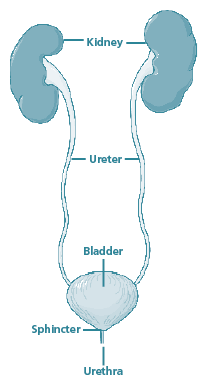What is a Mitrofanoff and why might my child need one?
The Mitrofanoff procedure creates a channel into the bladder through which a catheter (thin, plastic tube) can be inserted to empty the bladder of urine, instead of passing urine through the urethra. This channel – which looks like an extra belly button – is usually referred to as a ‘Mitrofanoff’, and is created in an operation under general anaesthetic.
Children who are incontinent (wet) may benefit from this procedure. It allows the bladder to be emptied several times a day, reducing the chance of the bladder leaking urine. It can be psychologically easier and physically less uncomfortable to insert a catheter into the Mitrofanoff rather than the urethra. It can also allow older children to lead a more normal life. The Mitrofanoff procedure is often used for children with bladder problems due to spina bifida, bladder exstrophy or bladder obstruction (posterior urethral valves).
What does the operation involve?
The surgeon will disconnect your child’s appendix from its usual position on the large intestine and open it up to form a tube. He or she will then connect one end to a small incision (cut) in your child’s bladder and the other end to another small incision in your child’s abdomen. The surgeon will also create a ‘valve’ where the tube joins the bladder, which squeezes shut as the bladder fills with urine. This will reduce the chance of urine leaking from the Mitrofanoff.

If your child has already had his or her appendix removed or if it is not suitable, the surgeon may need to use a piece of the small intestine to create the channel. The usual hospital stay is about seven days.
Are there any risks?
All treatments carry an element of risk, but this must be balanced against the quality of life without treatment. All surgery carries a risk of bleeding during or after the operation. Every anaesthetic carries a risk of complications, but this is very small. After an anaesthetic, your child may feel sick and vomit. He or she may have a headache, sore throat or feel dizzy. These side effects are usually short-lived and not severe.
Are there any alternatives?
Your child could catheterise using the urethra, which some children find quite difficult. Another alternative is to do nothing, and allow your child to remain wet.
What happens afterwards?
For the first day or two, he or she will have a drip giving fluids and medication, until the bowel starts to recover. The drip will be removed when your child starts eating and drinking again.
The surgeon will have inserted a catheter into the Mitrofanoff to keep it open. This should stay in place for three to four weeks after the operation.




